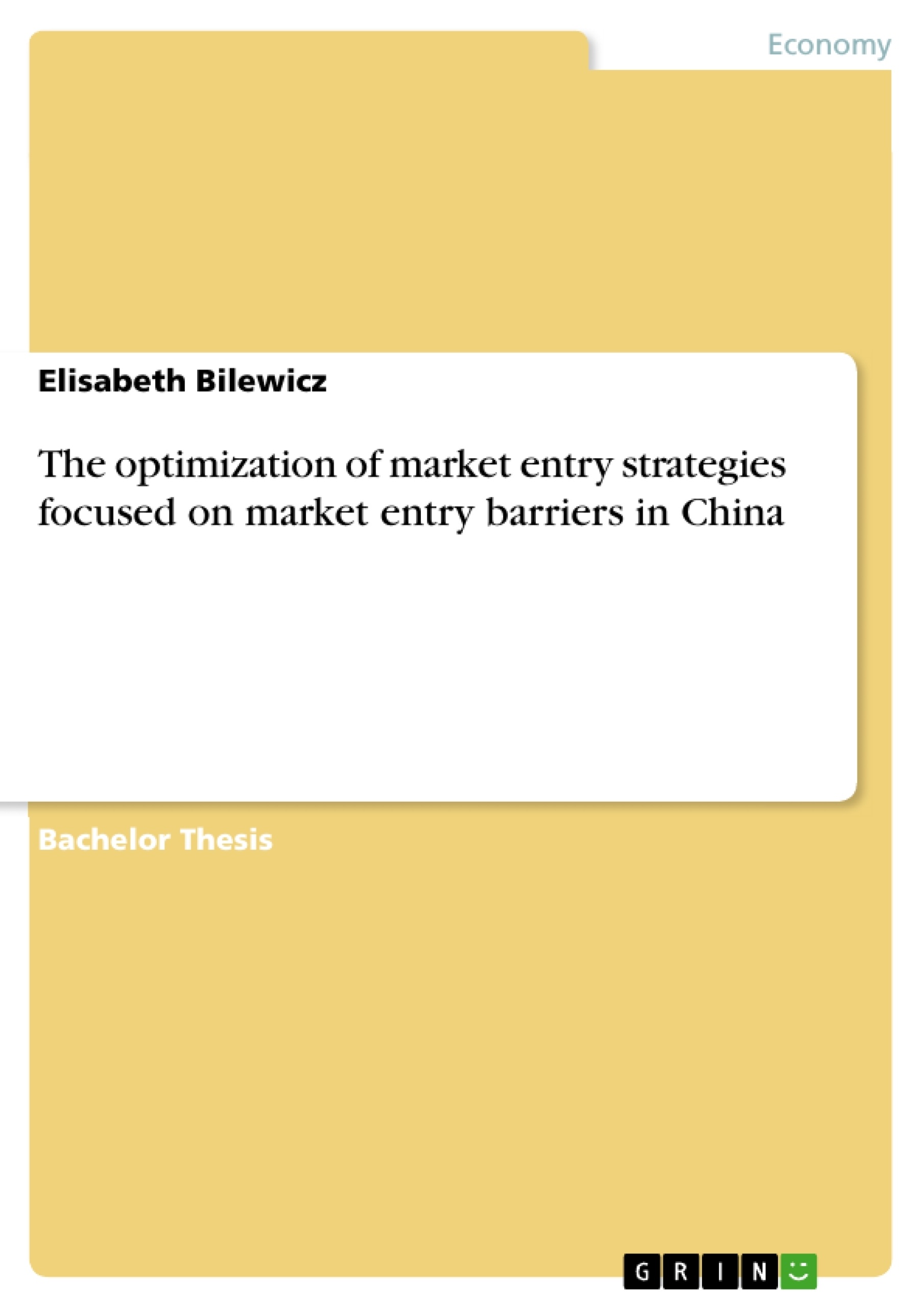The introduction of this paper as well as the summary and the scope of work are drawn in the first chapter. Chapter 2 deals with the definition and relevance of the problem and outlines the research methods that are applied in this work. The third chapter is composed of the theoretical background for the subsequent case. For this reason chapter 3.1 gives an overview of the relevant market entry strategies. Afterwards an analysis of the selected market entry strategy that is relevant for the case - the joint venture - is given in chapter 3.2. This analysis is subdivided in three areas: a definition (3.2.1), the explanation of different variations of this market strategy (3.2.2.) and finally a critical comment in chapter 3.2.3 which includes a comparison of its advantages and disadvantages. In chapter 3.3 relevant theories for market entry barriers will be introduced. Porters Industry analysis will be described in chapter 3.3.1. Afterwards, the SWOTanalysis, its origin and elements will be explained generally in chapter 3.3.2 and Hofstedes cultural value dimensions will be outlined in chapter 3.3.3. Out of these theories the selected elements for the case part will be illustrated in chapter 3.4. First, the SWOT analysis will be explained in detail in chapter 3.4.1. For this reason the selected market entry barrier elements will be outlined. Again this chapter is sectioned into three parts: a detailed definition of the SWOT elements weaknesses (3.4.1.1) and threats (3.4.1.2) is given, its use is clarified afterwards (3.4.1.3) and a critical comment is drawn finally (3.4.1.4). The elements of Hofstedes cultural value dimension are analysed the same way as the theoretical elements of the market entry strategy and elements of the SWOT analysis. First, all selected dimensions will be defined. Chapter 3.4.2.1 is concerned with Power Distance, followed by the dimensions of Uncertainty avoidance (3.4.2.2) and Individualism versus Collectivism (3.4.2.3.). This definition will be closed with the last dimension: Long-Term orientation in chapter 3.4.2.4. In the following there will given be a critical comment on Hofstedes theory in chapter 3.4.2.5. After the theoretical background is outlined in chapter 3, chapter 4 is concentrated on the case part and the application of the discussed theories and methodologies into a practical environment.
[...]
Inhaltsverzeichnis (Table of Contents)
- Introduction
- Executive Summary
- Scope of work
- Problem definition and Research methods
- Definition of Problem
- Reasoning and Motivation
- Research methods
- Primary Research
- Secondary Research
- Methods used in Thesis
- Theories
- Relevant theories for market entry strategies
- Export
- Indirect Export
- Direct Export
- Licensing
- International Franchising
- Joint Ventures
- Overseas branches and factories
- Subsidiaries
- Export
- Selected theory for market entry strategy
- Definition of joint ventures
- Types of joint ventures
- Equity joint ventures
- Contractual joint ventures
- X-joint ventures and Y-joint ventures
- Critical comment on joint ventures
- Relevant theories for market entry barriers
- Porters Industry Analysis
- The SWOT analysis
- Hofstedes cultural value dimensions
- Selected theory elements for market entry barriers
- Elements of SWOT analysis
- Weaknesses
- Threats according to Porter
- Use of SWOT analysis
- Critical comment on SWOT analysis
- Elements of Hofstedes cultural value dimensions
- Power Distance
- Uncertainty Avoidance
- Individualism versus Collectivism
- Long term-orientation versus short-term orientation
- Critical view on Hofstedes cultural value dimensions
- Elements of SWOT analysis
- Relevant theories for market entry strategies
- Case
- Economic area China: a framework
- Geographical Factors
- Social Factors
- Population
- Education
- Cultural and religious structure
- Legal factors
- Political Circumstances
- Economic System
- Description of the Chinese market
- Market Development
- Purchasing Power
- Trends of the energy market
- Application of Relevant Theory elements onto Case
- Definition
- Joint Ventures in China as market entry strategy
- Elements of SWOT analysis
- Weaknesses
- Threats according to Porter
- Elements of Hofstedes cultural value dimensions
- Power Distance
- Uncertainty Avoidance
- Individualism versus Collectivism
- Long-term orientation versus short-term orientation
- Economic area China: a framework
Zielsetzung und Themenschwerpunkte (Objectives and Key Themes)
This thesis aims to analyze and optimize market entry strategies for companies entering the Chinese market, focusing on market entry barriers. The study explores the interplay of relevant theoretical frameworks, including joint ventures, SWOT analysis, and Hofstede's cultural value dimensions, to develop a comprehensive understanding of the challenges and opportunities associated with market entry in China.
- Market entry strategies in China
- Market entry barriers in China
- Joint ventures as a market entry strategy
- Cultural influences on market entry strategies
- Application of theoretical frameworks to practical case studies
Zusammenfassung der Kapitel (Chapter Summaries)
The thesis begins with an introduction, outlining the executive summary and scope of work. Chapter 2 delves into the problem definition and research methods used, including primary and secondary research. Chapter 3 explores relevant theories for market entry strategies, focusing on joint ventures, licensing, franchising, and other approaches. It also examines relevant theories for market entry barriers, including Porter's industry analysis, SWOT analysis, and Hofstede's cultural value dimensions. Chapter 4 presents a case study on the economic area of China, providing a framework for understanding its geographical, social, legal, and economic factors. This chapter also applies the theoretical elements discussed in Chapter 3 to the Chinese case study, examining the specific challenges and opportunities for market entry.
Schlüsselwörter (Keywords)
This thesis focuses on the key concepts of market entry strategies, market entry barriers, joint ventures, SWOT analysis, Hofstede's cultural value dimensions, China, and the economic environment. These concepts are interwoven to provide a comprehensive understanding of the complexities associated with successful market entry in China.
- Citation du texte
- Elisabeth Bilewicz (Auteur), 2006, The optimization of market entry strategies focused on market entry barriers in China, Munich, GRIN Verlag, https://www.grin.com/document/67680



